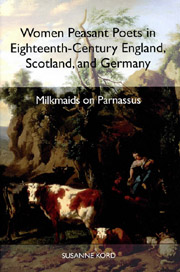Book contents
- Frontmatter
- Contents
- List of Illustrations
- Acknowledgments
- Introduction: Aesthetic Evasions and Social Consequences
- 1 Back to Nature: Bourgeois Aesthetic Theory and Lower-Class Poetic Practice
- 2 The Wild and the Civilized: Poet Making
- 3 The Life As the Work: Counterfeit Confessions, Bogus Biographies, Literary Lives
- 4 A Literature of Labor: Poetic Images of Country Life
- 5 Inspired by Nature, Inspired by Love: Two Poets on Poetic Inspiration
- 6 Of Patrons and Critics: Reading the Bourgeois Reader
- Conclusion: On the Gender and Class of Art
- Appendix: Short Biographies of Women Peasant Poets
- Works Cited
- Index
Introduction: Aesthetic Evasions and Social Consequences
Published online by Cambridge University Press: 05 February 2013
- Frontmatter
- Contents
- List of Illustrations
- Acknowledgments
- Introduction: Aesthetic Evasions and Social Consequences
- 1 Back to Nature: Bourgeois Aesthetic Theory and Lower-Class Poetic Practice
- 2 The Wild and the Civilized: Poet Making
- 3 The Life As the Work: Counterfeit Confessions, Bogus Biographies, Literary Lives
- 4 A Literature of Labor: Poetic Images of Country Life
- 5 Inspired by Nature, Inspired by Love: Two Poets on Poetic Inspiration
- 6 Of Patrons and Critics: Reading the Bourgeois Reader
- Conclusion: On the Gender and Class of Art
- Appendix: Short Biographies of Women Peasant Poets
- Works Cited
- Index
Summary
Literary history, as it has been written for eighteenth-century Britain and Germany, has traditionally assumed three things: first, that most, if not all, “great” writers of the age were male and middle class; second, that this was directly related to the bourgeoisie's rise to power and cultural preeminence following the emancipation of the middle- class artist from seventeenth-century aristocratic patronage; and finally, that the two aspects that make the new bourgeois art “Art” and that have, in fact, from the eighteenth century on defined all Art as such, are its independence from social, political, and biographical context and its resulting ability to embody universally human values, transcending all specificities of gender and class. If this study concentrates on women writers of the lower orders — authors who were neither male nor middle-class —, if it moreover professes itself indebted to both Marxist and feminist criticism, it places itself outside of these parameters. In contrast to books on Goethe or Coleridge, whose relevance is assumed, such a study is forced to explain why it makes its subject literature that is so manifestly not “Art” by the bourgeois definition, why it should matter that this literature was produced by lower-class women rather than proper writers, and why a study that will automatically be assumed to be social and political in outlook should be able to lay claim to a readership primarily interested in the aesthetic.
This book is the first comparative investigation of the literature of lower-class women poets in eighteenth-century England, Scotland, and Germany.
- Type
- Chapter
- Information
- Women Peasant Poets in Eighteenth-Century England, Scotland, and GermanyMilkmaids on Parnassus, pp. 1 - 18Publisher: Boydell & BrewerPrint publication year: 2003

